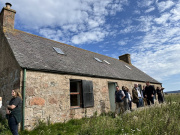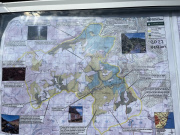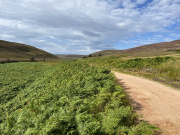Community Engagement at Glen Dye Moor
In 2021, the 6,300ha (15,700 acres) Glen Dye Moor was acquired by an investment vehicle on behalf of Aviva and Par Equity (a Scottish-based forestry investment fund manager). They entered a partnership with Scottish Woodlands to design, implement and manage an ambitious peatland restoration and woodland creation project. This forms part of Aviva’s stated commitment to achieving net zero across its Real Assets platform by 2040.
Project description
Over a period of 5 years, the project plan includes extensive peatland restoration work across c.1800 hectares and new tree planting over c.3000 hectares, comprising up to 1,000 hectares of productive conifer and 2,000 hectares of native woodland. However, the project website www.glendyemoor.com emphasises that “the project goes well beyond a quest for carbon and any potential return on investment in natural capital that this emerging market may bring,” and sets out commitments for community engagement and benefits including employment opportunities.
Approach
Par Equity and Scottish Woodlands have brought together a delivery team that is committed to achieving good practice in community engagement alongside good stewardship of land, as well as delivering further community benefits through the work. The Glen Dye Moor website makes public the commitment to achieving multiple benefits from the project: for the local community; for the environment; as well as creating a return for investors. From the outset Par Equity has stated a commitment to manage the land in alignment with the Scottish Land Rights and Responsibilities Statement and protocols. They have been in regular contact and dialogue with the Commission as they develop their approach.
Transparency
A regularly updated website contains current information about the project, and includes an online form where people can get in touch anonymously, if they wish. Requests for information or enquiries about opportunities are made via an email inbox monitored by Scottish Woodlands. There is signage onsite at entry points, which is designed in such a way as to be easily updated as the project develops, and includes QR codes linking to the project website. Scottish Woodlands has a local office in Banchory, and their staff are building local connections.
Engagement and involvement of the local community
As part of the pre-acquisition process, work was done to identify interested parties and user groups already active on the land, and those identified as part of this process were updated on the day of purchase on the change of ownership, aspirations for the site, and a suite of contact numbers for the key parties. This process has continued post-acquisition to enable the delivery team to be proactive in engaging with the wide range of stakeholders. As part of the acquisition action was taken to ensure that current users, including the Mountain Bothy Association and the Glen Dye Rifle Club had an ongoing formal agreement to continue their activities on the land. This also ensures they are considered in the long-term decision-making process.
Early contact and ongoing regular communication with three community councils in the area has also taken place and is ongoing. Efforts have been made to reach out to local groups and there are plans to involve local Scout groups with activity onsite, as well as to organise site visits and volunteer days.
While the land covered by the project has for some time been entirely depopulated, during the public consultation in 2022 the team engaged with local community members, including some who have living memory of people who formerly occupied the land. Feedback from local people and research of the archaeology, culture and history of the site has led to design changes for the afforestation scheme, such as areas to be left unplanted to ensure that the cultural and heritage value is retained.
Through 2023 management plans continued to develop, and engagement with the community - through open drop-in sessions and targeted communications - has included sharing drafts for comment and input from the local community and other stakeholders. This feedback will continue to be incorporated into revised plans. The delivery team are keen to be approachable and responsive and can share specific examples of where feedback has changed the plans.
Employment
The Glen Dye Moor website states the project commitment to creating the equivalent of 40 years of full time employment over the first five years based on the aspirational plans. It is clear that this is likely to be an underestimate. Even in advance of SG policy , Par has sought along with their site managers Scottish Woodlands to embed fair work conditions into contracts with suppliers, and a preference for local suppliers in the tendering processes. Training and development opportunities, particularly around forestry and peatland restoration, are being actively developed with partners.
What's next?
In terms of community engagement their future approach will be set out in their community engagement plan to be published in Q1 2024.
There is an interest and appetite for sharing the learning experiences from the project development and roll out. There is clearly opportunity for lessons to be learned as all aspects of the work develop – from complex and extensive peatland restoration, to sharing learning about good practice in community engagement and involvement for this type of project. Over time this has potential to deliver a significant resource for future projects. The team has extended an invitation to potential collaborators or research projects on the Glen Dye Moor website, stating that, “Opportunities for local schools, colleges, universities and industry participants to utilise the site for educational and research purposes are anticipated. We welcome representatives to get in contact with us via the website to explore this further.”



